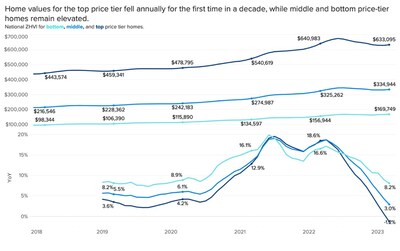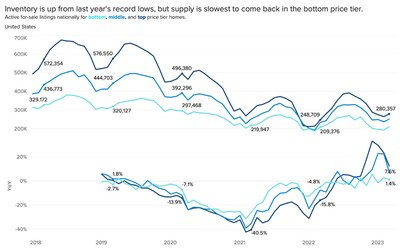Entry-level home shoppers most likely to face bidding wars this spring
The latest Zillow analysis, dated April 20, 2023, reveals significant trends in the housing market, particularly for entry-level home buyers. Notably, the least-expensive one-third of homes experienced a remarkable 8% annual price increase, amounting to nearly
- Entry-level home prices increased by 8%, translating to nearly $13,000.
- Mid-tier homes appreciated by 3%.
- Entry-level homes gained at least 60% in value since February 2020 in several major markets.
- Top-tier homes depreciated by 1%, the first decline in over a decade.
- Inventory for the least-expensive homes increased by only 1%, while higher tiers saw greater increases.
- March had a 22% drop in new listings compared to the previous year.
Insights
Analyzing...
- Prices rose by
8% annually for the least-expensive one-third of houses; the most-expensive homes lost value for the first time in more than a decade. - The recent uptick in inventory hasn't included the least-expensive houses — bottom-tier inventory is up just
1% from last year, compared to a13% boost for top-tier homes.
"Buyers shopping for the least-expensive homes this spring aren't noticing much difference from the pandemic-era market heat," said
Typical home values for the least-expensive one-third of houses rose
Entry-level homes have exploded in value over the course of the pandemic across the
Mortgage-interest rate hikes do more damage to monthly payments as home prices rise. This helps explain why top-tier home values are falling fastest annually in some of the most-expensive markets:
A slight annual recovery in inventory has left out entry-level shoppers. There are just
Rate lock — the effect of relatively high mortgage rates dissuading current homeowners from selling — is contributing to a lower flow of new listings across price tiers. March saw record-low new listings for this time of year, down
In the recent past, entry-level shoppers had an easier time finding discounts than their well-heeled colleagues, but that comparative benefit is gone now, too. The share of mid- and top-tier homes that sold above list price rose far above the bottom-tier share through most of the pandemic. Super-low rates had cranked up demand for more-expensive houses. But after mortgage rates peaked at
Metropolitan | Bottom Tier | Top Tier | Bottom Tier | Top Tier | Bottom Tier | Top Tier |
8 % | -1 % | 48 % | 33 % | 1 % | 13 % | |
5 % | 0 % | 34 % | 19 % | -24 % | -9 % | |
0 % | -6 % | 35 % | 28 % | -18 % | 2 % | |
6 % | 0 % | 40 % | 19 % | -19 % | -13 % | |
2 % | -1 % | 44 % | 40 % | 3 % | 15 % | |
4 % | 2 % | 41 % | 33 % | 12 % | 28 % | |
3 % | -2 % | 26 % | 22 % | -32 % | -3 % | |
8 % | 4 % | 43 % | 31 % | -7 % | -12 % | |
16 % | 6 % | 64 % | 54 % | 18 % | 48 % | |
6 % | 1 % | 64 % | 39 % | -1 % | 9 % | |
4 % | -1 % | 34 % | 24 % | -32 % | 4 % | |
-2 % | -3 % | 46 % | 40 % | 1 % | 55 % | |
-5 % | -14 % | 26 % | 16 % | -37 % | 2 % | |
1 % | -4 % | 48 % | 34 % | 0 % | 15 % | |
5 % | 1 % | 54 % | 27 % | 9 % | -2 % | |
-3 % | -11 % | 35 % | 32 % | -32 % | 6 % | |
1 % | -1 % | 26 % | 23 % | -22 % | 8 % | |
1 % | -6 % | 41 % | 43 % | -38 % | -1 % | |
8 % | 2 % | 69 % | 51 % | 26 % | 59 % | |
-1 % | -5 % | 29 % | 25 % | -4 % | 47 % | |
8 % | 2 % | 35 % | 25 % | -7 % | -12 % | |
8 % | 2 % | 45 % | 27 % | 2 % | -1 % | |
8 % | 3 % | 53 % | 43 % | 12 % | 41 % | |
7 % | 1 % | 65 % | 45 % | 30 % | 29 % | |
5 % | 1 % | 43 % | 37 % | 42 % | 63 % | |
-1 % | -4 % | 30 % | 25 % | -32 % | 11 % | |
-3 % | -7 % | 32 % | 24 % | -36 % | 2 % | |
0 % | 0 % | 45 % | 21 % | -6 % | 9 % | |
9 % | 3 % | 52 % | 32 % | -17 % | 3 % | |
-6 % | -8 % | 48 % | 45 % | 30 % | 95 % | |
0 % | -5 % | 34 % | 27 % | 9 % | 38 % | |
7 % | 2 % | 51 % | 31 % | 5 % | 12 % | |
8 % | 3 % | 54 % | 33 % | -10 % | 16 % | |
6 % | 1 % | 57 % | 37 % | 8 % | 32 % | |
6 % | 4 % | 47 % | 30 % | -1 % | 2 % | |
-1 % | -11 % | 31 % | 24 % | -54 % | 16 % | |
6 % | -1 % | 55 % | 48 % | 25 % | 67 % | |
8 % | 3 % | 40 % | 29 % | -16 % | -9 % | |
6 % | 2 % | 42 % | 35 % | -34 % | -13 % | |
7 % | 2 % | 61 % | 51 % | 49 % | 63 % | |
8 % | 3 % | 39 % | 21 % | -32 % | -21 % | |
10 % | 4 % | 56 % | 31 % | -9 % | 77 % | |
4 % | 0 % | 54 % | 43 % | 2 % | 66 % | |
8 % | 2 % | 62 % | 35 % | 7 % | 36 % | |
21 % | -3 % | 67 % | 21 % | -12 % | -8 % | |
10 % | 2 % | 47 % | 27 % | -6 % | 2 % | |
11 % | -1 % | 34 % | 17 % | 49 % | 48 % | |
-2 % | -5 % | 43 % | 36 % | 6 % | 66 % | |
9 % | 5 % | 43 % | 31 % | -32 % | -9 % | |
4 % | 2 % | 41 % | 28 % | -1 % | -2 % | |
*Table ordered by market size | ||||||
About Zillow Group
![]() View original content to download multimedia:https://www.prnewswire.com/news-releases/entry-level-home-shoppers-most-likely-to-face-bidding-wars-this-spring-301802601.html
View original content to download multimedia:https://www.prnewswire.com/news-releases/entry-level-home-shoppers-most-likely-to-face-bidding-wars-this-spring-301802601.html
SOURCE Zillow










